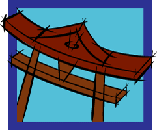 |
|
"You like Kabuki?!"A Period Drama? It's Drama, Periodby Tim YoungFrom SIF SATELLITE 51, Fall 1998They file noisily, excitedly into the theater, most of them female and over the age of 50. The hall has two balconies; most of the 1,906 seats are full. We rent small radios with earphones, in order to hear an English explanation of the performance, and go to third floor, where we wedge ourselves into undersized seats with virtually no legroom. Looking up, I notice that the theater is in rather bad repair. Evidence of water damage--perhaps a leak in the roof--is obvious on the ceiling near the stage. It's rather unfortunate, since we are in the nation's major showcase for one of its best-known (and yet not verywell-known) forms of drama. The sound of wood hitting wood signals us that the show is about to begin. An ornate curtain embroidered with an image of Mt. Fuji, paid for by a major corporation, is lifted, and then a traditional black, red, and green striped curtain is pulled aside. Two actors stand on a nearly bare stage, dressed in brightly-colored costumes, their faces covered with white makeup, designs drawn in black and red around their eyes and mouth. This is the Kabukiza theater, and the Kabuki play is beginning. Japan's Kabuki drama traces its roots back nearly four hundred years. It is a very stylized type of drama, relying more on symbolism or form, even on the audience's imagination, than on striving for realism, as Western drama often does. In fistfights, the actors are clearly not hitting each other. A house's doorway, which was very important early in a scene, may be removed by stagehands when it will simply be in the way for the last part of the same scene. A walk once around the stage represents two characters' walk down to a wine cellar, where they then open an imaginary door. I have always found Kabuki fascinating. But I've never quite been able to explain why. Initially, of course, it was just part of the overall magic of the land I had begun to feel attracted to in high school. Still, some may find it surprising that I can accept Kabuki stylization on its own terms. Other foreigners who have seen Kabuki have told me that they found the dramatic performances to be "overdone", and couldn't feel comfortable with the idea of men playing the roles of women (female actors have been prohibited in Kabuki since 1629--originally by law, now simply by tradition). While I don't always find male Kabuki actors believable as women, somehow it doesn't matter to me. Along with the imaginary scenery and props of some plays, onnagata--men who specialize in women's roles--make Kabuki less realistic than Western plays, but I find that those kinds of concerns are offset by the my fascination at observing the skill with which the actors handle these conventions. As for my Japanese acquaintences, many of them are quite surprised to hear I've been to Kabuki five times, and, perhaps even more surprising to them, that I enjoyed it. "I've never been to Kabuki," many of them tell me. Most of those who have seen Kabuki saw it either on TV or on a field trip in junior high or high school. If their teachers thought that exposing teenagers to Kabuki would get them interested in it, they had probably forgotten what it's like to be a teenager. How many teens are interested in anything that happened more than two weeks ago? If you show them drama from several hundred years ago, whether it's Kabuki or Shakespeare, most of them will decide it's boring. The stylization is hard to understand, the language is old and outdated (at Kabukiza, radios for hearing a Japanese explanation during the performance are also available!). Many of these teenagers apparently spend the rest of their lives believing that Kabuki is boring. Instead, there should be some way of forcing adults to watch it; the Japanese I have attended Kabuki with, including my wife, were amazed to find themselves enthralled by it. Another option: show the teenagers the Kabuki plays with sex and violence in them! On my most recent Kabuki excursion, I saw Onnagoroshi Abura no Jigoku, which ends with a silent, horrifying scene where Yohei, desperate for money to pay off his debts, brutally murders a woman with whom he has been friends in order to steal cash from her house. This scene was so shocking and gripping to me that, for the first time ever, I actually forgot I was watching Kabuki. I was watching a drama, period. Young people might become interested in Kabuki if they realized how some Kabuki conventions carry over into modern drama--including children's shows and movies. Doesn't watching a guy in a lizard costume stomp on miniature buildings take at least as much "suspension of disbelief" as watching an onnagata actor? Hollywood, with its Western obsession with realism, sapped Godzilla of his charm and made him into just another Jurassic Park inhabitant. Another example is the mie. At a climactic point in a play or dance, one or more actors freeze in a dramatic pose. This seems to me to have carried over into cartoons like Sailor Moon, where the heroine goes through a magical, time-consuming transformation into her super-hero identity, ending with a mie-like pose in which she appears ready for action. This pose is invariably frozen in silence on the screen for two or three seconds. So the stylization of Kabuki survives in Japanese popular culture, though I wonder how many Japanese have noticed this. Kabuki was once "popular culture" too, of course, frequently attended by young people rather than senior citizens. If more Japanese could see just how interesting it can be, perhaps it could be popular among young people again. |
Copyright 2003  This page last updated
November 1, 2002
. E-mail Tim
This page last updated
November 1, 2002
. E-mail Tim
